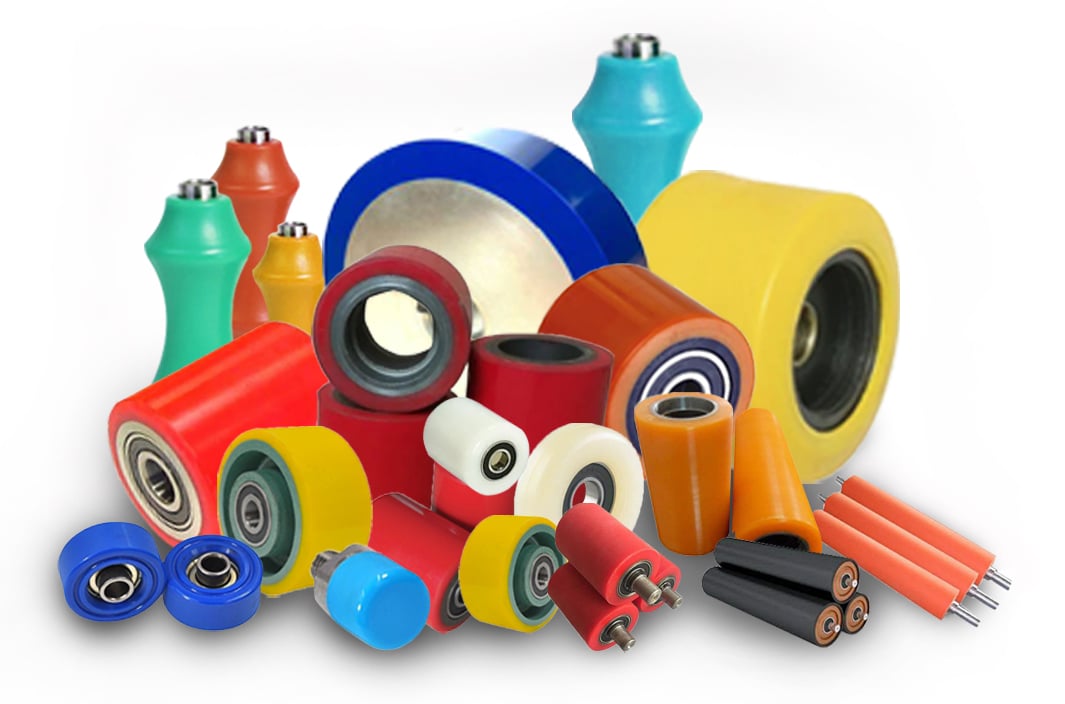Polyurethane Vs Rubber Rollers
Industrial rollers are the unsung heroes of manufacturing and various other sectors, playing a pivotal role in ensuring smooth operations, precise product handling, and optimal machinery performance. As we delve into the landscape of roller materials, two names consistently emerge at the forefront: Polyurethane and Rubber. In our exploration of Polyurethane Vs Rubber Rollers, we aim to provide a comprehensive comparison, shedding light on the distinct features, benefits, and potential drawbacks of each, thus empowering businesses to make informed decisions tailored to their specific needs.

Common Traits: Understanding the Similarities
Polyurethane and Rubber share certain essential traits that have made them popular choices across industries. Some of their shared characteristics include:
- Elastic Properties: Both materials boast impressive elasticity, allowing them to return to their original shape after stress.
- Acid Resistance: In industrial settings, they offer notable resistance to various acids, enhancing durability.
- Metal Core Adherence: Both adhere firmly to metal cores, ensuring roller durability and optimal performance.
- Machinability: They can be shaped and machined to fit specific dimensions and requirements.
Polyurethane Rollers: An In-Depth Analysis
Advantages
Abrasion Resista nce: Polyurethane rollers are designed to provide top-notch performance even under conditions of intense friction and significant load -bearing, marking them as superior in environments where wear and tear are common.
- Durometer Range: Urethane rollers offer a diverse durometer scale, spanning from a soft 10 Shore “OO” to a hard 70 Shore “D”. This vast range accommodates a wide array of applications, giving manufacturers flexibility in their roller choice based on specific requirements.
- Non-Marking Property: A significant edge that polyurethane rollers possess is their non-marking characteristic. This ensures that products remain untainted and pristine, free from any unsightly marks or potential contaminants during processes.
- Wet Environment Durability: Polyurethane showcases remarkable resistance to water and moisture, making it an ideal choice for operations that involve damp conditions. Even when submerged or consistently exposed to wet surroundings, these rollers remain robust and free from degradation.
- Chemical Composition Flexibility: Polyurethane stands out due to its adaptability at the chemical level. Manufacturers have the luxury of tweaking its formulation to cater to specific needs, allowing for a custom-tailored roller that precisely matches operational demands.
Disadvantages
- Cost: The initial outlay can sometimes surpass that of rubber.
- Chemical Sensitivities: While they exhibit considerable resistance, certain aggressive chemicals can compromise them.
Read “Polyurethane Rollers: Advantages & Uses”for further understanding.
Rubber Rollers: Strengths and Limitations
Advantages
Natural Elasticity: Rubber rollers are renowned for their inherent elastic properties. This elasticity makes them pliable and adaptable, suitable for a plethora of applications across various industries.
- Tried and Tested: Rubber has been a staple in the roller industry for many years. Its long-standing history of usage attests to its reliability and the trust industries have vested in it over the decades.
- Lower Initial Cost: Financially speaking, rubber rollers often present a more economical choice initially. Their upfront costs are generally lower compared to their polyurethane counterparts, making them an attractive option for those on a tighter budget.
- Customization: A notable strength of rubber rollers is the possibility of infusing them with specific fillers. This addition allows manufacturers to tweak and alter the properties of the rubber to better suit specific operational needs.
Disadvantages
- Durometer Limitation: While rubber rollers are versatile, they do have their boundaries in terms of hardness. Their durometer scale is typically confined between 30 Shore A to 90 Shore A, which might not cater to all industrial requirements.
- Marring Issue: A significant drawback of rubber rollers is their tendency to leave marks. Products, especially those of a delicate or sensitive nature, are prone to scuffing or marking when processed with rubber rollers.
- Wet Environment Vulnerability: Rubber, especially when exposed to damp conditions for prolonged periods, is susceptible to rotting or degrading. This makes them less ideal for operations that are consistently damp or wet.
- Chemical Sensitivities: Rubber is not immune to the effects of certain chemicals. Exposure to some can significantly alter its properties, potentially diminishing its efficiency and lifespan.
- Abrasion Resistance: When pitted against polyurethane, rubber falls short in terms of abrasion resistance. This makes them less suitable for high-friction environments where wear and tear are prevalent.
Comparative Overview: Polyurethane Vs Rubber Rollers
To simplify the understanding of the core differences and similarities between polyurethane and rubber rollers, here's a side-by-side comparison table. It sheds light on their attributes, offering a quick yet comprehensive reference:
|
Attribute |
Polyurethane Rollers |
Rubber Rollers |
|
Elasticity |
Superior in certain formulations, adaptable to varying hardness. |
Inherently elastic, suitable for many applications. |
|
Abrasion Resistance |
Highly resistant, especially under heavy loads and high friction. |
Less resistant compared to polyurethane. |
|
Wet Environment Suitability |
Resistant to degradation, even when submerged or exposed to moisture. |
Vulnerable to rotting or degrading in damp conditions. |
|
Chemical Composition |
Offers room for custom formulations, adapting to specific needs. |
Might be altered with specific fillers, but sensitive to certain chemicals. |
|
Propensity to Leave Marks |
Non-marking property ensures minimal product contamination. |
Has a propensity to leave marks, especially on delicate items. |
|
Manufacturing & Industrial Use |
Versatile and widely used in various manufacturing processes. |
Long-standing history in numerous industries. |
|
Environmental Impact |
Depending on the formulation, some types might be more eco-friendly. |
Generally, has a larger environmental footprint, especially if not recycled. |
|
Cost |
Often a higher initial investment than rubber. |
Typically less expensive initially but may incur costs in the long run due to durability issues. |
Conclusion
In evaluating Polyurethane Vs Rubber Rollers, both materials present unique advantages. Polyurethane excels in abrasion resistance and versatility, while rubber boasts inherent elasticity. When choosing, consider your specific operational needs to determine the optimal solution. This analysis aims to guide your informed decision between these two prominent roller materials.
Have you had experiences using either Polyurethane or Rubber Rollers in your industry? Share your thoughts in the comments below!
Keep Learning








